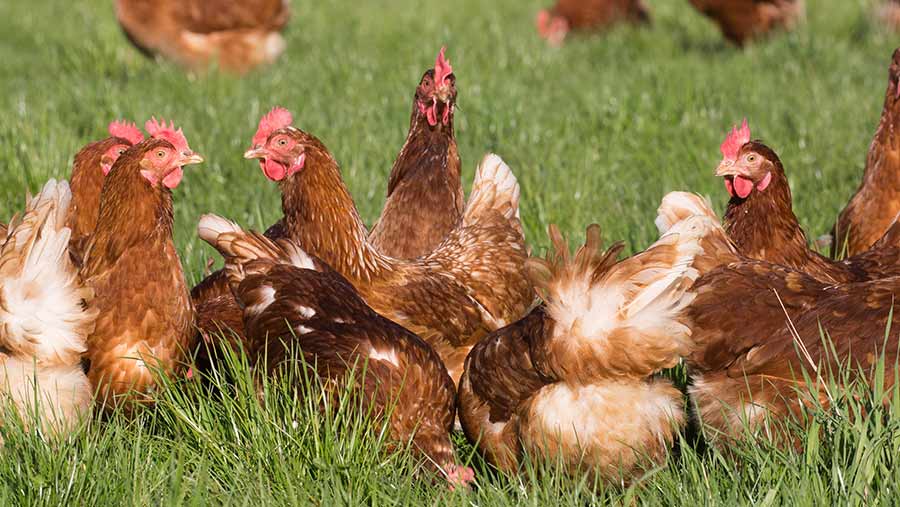Outlook 2019: Poultry – challenging times ahead
 © Tim Scrivener
© Tim Scrivener The UK poultry sector has seen yet another year of change, with an increase in the number of broiler and layer units alongside further concentration of the processing and packing sector.
The egg sector, notably free-range, is experiencing a particularly challenging time as the number of units increases, says Andersons’ Lily Hiscock.
“Producers are preparing for 2025, when most retailers have committed to phasing out colony eggs (Morrisons has committed to cage-free by 2022); but this has led to an oversupply, with downward pressure on prices.”
This has been accentuated by grant funding in parts of Northern Ireland and Wales that has encouraged further investment in poultry units, despite limited demand at present, she says.
Key areas
- Buy feed ahead for longer periods (12 months+) where possible to counter rising prices
- Shorten the clean-out/ turnaround period to get more batches in the year and increase annual egg production
- Labour – 60% of the UK’s direct poultry labour is from the EU so producers should be working to secure labour for the longer term to ensure no disruption post Brexit
- Review markets to identify opportunities. For example, if free-range demand from retailers is limited, there may be opportunities to add value by selling direct/changing system, for example to organic.
“Grant funding in some situations has the unintended effect of encouraging producers to sell at a low price, below the cost of production in some cases, to gain a contract, which is a requirement of the grant offer.
“While grant funding may be helpful, business expansion should not simply occur because a grant is available. Producers must not be led by the grant, but use it to help them become leaders.”
Ms Hiscock expects the free-range egg sector to remain challenging over the next one to two years, as supply and demand remain finely balanced. Furthermore, with input costs rising, specifically feed, the margin from production has reduced.
Plan changes carefully
Given these pressures, any planned expansion or diversification must be carefully considered, and the following should be taken into account :
- Contract to supply: most of the egg and broiler sector is controlled by a few players, with many farmers operating on a contract rearing or management basis. Before any investment, understand whether a contract will be available and the likely terms.
- Obtain planning permission: some areas have become overpopulated with poultry units (broilers and layers) leaving limited opportunity for more units. For example, chicken, turkey and duck processor Avara Foods recently decided to expand its business in Northamptonshire, rather than Herefordshire, as the density of poultry units in Hereford has become too great
- Environmental obligations: the government’s planned Clean Air Strategy could put more pressure on the poultry sector. For units operating more than 40,000 bird places, holding an IPPC (integrated pollution prevention and control) environmental permit (perhaps for more birds than in situ) could become a valuable tool. Some suggest it could become a form of quota in future, with permits being traded.
Maintain cost focus
For those already operating in the poultry sector, the key, as ever, is to focus on the true cost of production to ensure a profit can be achieved in the most challenging times, Ms Hiscock says.
“Although challenging, the poultry sector is well placed to meet UK consumer requirements post Brexit. The outlook is positive, for those who can operate efficiently, profitably and react to the inevitable changes in the business environment.”
FW says – Jake Davies, poultry editor
As the Andersons report suggests, razor-sharp focus on costs will be critical over the next 12 months, with many feeling oversupply may bite after years of strong capacity growth.
Domestic broiler production continues to rocket. The latest figures show that just shy of 22 million birds each week are being slaughtered in the UK, compared with about 18 million in the final weeks of 2015.
It is also worth considering the impact of imports. The Ukraine has gone from selling almost nothing into the European market two years ago to more than 200,000t in the first nine months of 2018. Another big exporter, Brazil, has been beset with meat-quality scandals, but will be back on its feet before too long.
Highly-geared egg businesses should review their finances, with the expectation that lean times are ahead. A number of packers have already cut their egg price and feed prices continue to creep upwards – rising by about £20/t in 2018 by our estimate.
